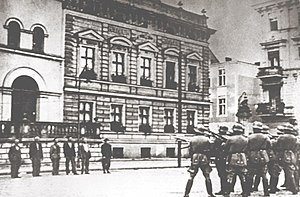Intelligenzaktion
| Intelligenzaktion | |
|---|---|

Itelligenzaktion: In occupied Poland, on 9 September 1939, the Nazis publicly executed twenty-five prominent citizens, before the Municipal Museum, in the Market Square of Bydgoszcz.
To terrorise the townsfolk, the Nazis displayed the bodies for six hours. |
|
| Location | Occupied Poland |
| Date | 1939 – 1940 |
| Target | Polish intellectuals, civic officials, and the upper classes. |
|
Attack type
|
Massacres |
| Weapons | Automatic weapons |
| Deaths | 100,000 (61,000 from lists) |
| Perpetrators |
|
Intelligenzaktion (German pronunciation: [ɪntɛliˈɡɛnt͡s.akˌt͡sjoːn], Intelligentsia action) was a secret genocide conducted by Nazi Germany against the Polish élites (the intelligentsia, teachers, priests, physicians, et al.) early in the Second World War (1939–45). The genocide operations were conducted to realise the Germanization of the western regions of occupied Poland, before territorial annexation to the German Reich.
The ethnic cleansing operations of Intelligenzaktion killed 100,000 Polish people; by way of forced disappearance, the Nazis imprisoned and killed selected citizens of Polish society, identified before the war as enemies of the Reich; they were buried in mass graves at remote places. To facilitate the depopulation of Poland, the Nazis terrorised the general populace with the public, summary executions of selected intellectuals and community leaders, before effecting the expulsions of the general population from occupied Poland. The executioners of the Einsatzgruppen death squads and the local Volksdeutscher Selbstschutz, the German-minority militia, pretended that their police-work was meant to eliminate politically dangerous people from Polish society.
The Intelligenzaktion was a major step to implementing Sonderaktion Tannenberg (Operation Tannenberg), the installation of Nazi policemen and functionaries — from the SiPo (composed of the Kripo and Gestapo), and the SD — to manage the occupation and facilitate the realisation of Generalplan Ost, the German colonization of Poland. Among the 100,000 people killed in the Intelligenzaktion operations, approximately 61,000 were of the Polish intelligentsia, whom the Nazis identified as political targets in the Special Prosecution Book-Poland, compiled before the war began in September 1939. The Intelligenzaktion occurred soon after the German invasion of Poland (1 September 1939), and lasted from the autumn of 1939 until the spring of 1940; the Nazi genocide of the Polish nation continued with the operations of German AB-Aktion operation in Poland.
...
Wikipedia
